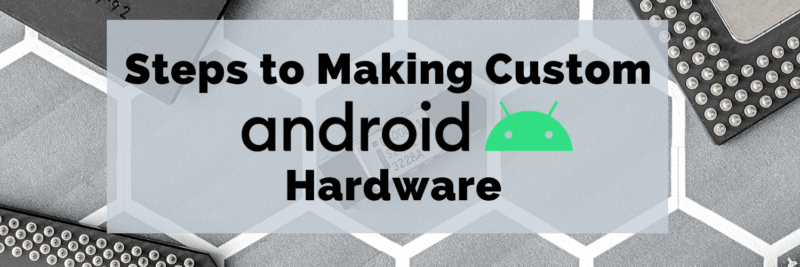When architecting custom Android hardware the first thing to consider is which CPU to use. A CPU is the central IC chip that powers a digital product, sometimes referred to as the ‘brains’ of a product. Choosing the CPU is the most fundamental design decision for your product because the capabilities and limitations of this IC predicate the capabilities of the entire device.
Two CPU companies that continue to dominate homegrown China products are Mediatek (Taiwan) and Spreadtrum (China). While Qualcomm, globally, is the leading brand for top tier mobile phone CPUs, it’s more suitable for high volume (100k+ units) consumer devices than lower volume (10k+) custom devices. Designing phones with Qualcomm CPUs requires more engineering expertise so development costs are higher. The performance benefits that Qualcomm CPUs provide are often overkill for what custom device customers need anyway.
Mediatek and Spreadtrum advertise many different CPUs on their websites. The reality is that only a few of them are commonly used by players in Shenzhen’s manufacturing ecosystem, the world’s source for tech hardware. The websites show several older and brand new CPUs, neither of which are good for custom products. Older CPUs may soon become obsolete and lack performance. Brand new CPUs are often too new for stable mass production and their features are overkill for the needs of most custom projects. The CPUs that have become popular gained traction because they offer the best value for the segment they serve.
(Relatively) High End Segment 4G
Both Mediatek and Spreadtrum are showing 5G chips on their website and a few large (mostly Chinese) mobile phone brands have already released phones using CPUs from Mediatek’s 5G Dimensity line. When new chips come out larger brands which reliably sell high volumes are the first to market with products. It takes a lot of engineering resources to develop a product using a new chip which is why CPU manufacturers partner with high volume brands to release the initial products. Once these brands have come out with products and the system becomes more stable Shenzhen’s smaller development companies start releasing products for smaller brands.
Because 5G solutions aren’t stable enough for smaller market brands yet they’re still not ready for most custom projects. At this point 4G CPUs are still the most practical for custom projects as the engineers are most comfortable making products on these platforms. Therefore, even for the high end segment, this article focuses on 4G CPU options.
Mediatek G90
This is Mediatek’s top of the line 4G CPU. It offers high performance for playing resource intensive video games and high end camera support. Mediatek describes it like this:
“An upgraded octa-core CPU boosts speeds up to 2.05GHz. Using a mix of the latest Arm Cortex-A76 and Cortex-A55 in combination with a large L3 cache, the G90 series increases multi-threaded performance up to 9%1 beyond direct competitors.
With speeds up to 800MHz, the latest Arm Mali-G76 3EEMC4 GPU can play Fortnite and PUBG incredibly smoothly, blazing through Manhattan benchmark up to 26%1 faster versus direct competitors.
Up to 10GB of LPDDR4x at 2133MHz1 (4266MHz1 effective) provides generous bandwidth and memory capacity, while the latest UFS 2.1 storage yields ultra-fast data-streaming.”
Mediatek P70
The P70 replaces the successful P60 offering up to 13% faster performance and 35% lower power consumption. The chip includes an upgraded dedicated AI Processor Unit (APU) that provides up to 30% more processing efficiency than its predecessor. This chip is marketed towards gamers, camera enthusiasts, and advanced AI applications. Could be a good choice for custom products that need high performance onboard processing. Here’s what Mediatek has to say:
“The MediaTek Helio P70 incorporates a powerful Arm Cortex-A73/A53 octa-core CPU complex with an impressive Arm Mali-G72 class GPU. Versus the prior P60, the faster clock speeds generate up to 13% more performance. In-hand, there’s support for 20:9 displays at Full HD+ resolution that allow users to enjoy the most beautiful and modern smartphone designs with full fascia coverage.
MediaTek’s exclusive CorePilot 4.0 technology manages how tasks are assigned between processing resources, with a power management focus that’s on maintaining a sustainable, fast user experience through thermal management, UX monitoring and Energy Aware Scheduling (EAS+).”
Mediatek G70
This chip offers similar, but slightly reduced, features as the P70. It became mainstream in early 2020, about a year after the P70. Mediatek has this to say:
“The G70 incorporates a pair of powerful Arm Cortex-A75 CPUs operating up to 2GHz, plus six Cortex-A55 CPUs in a single, octa-core cluster. These are interlinked and share a large L3 cache for improved performance plus up to 8GB of fast LPDDR4X memory. For gaming, an efficient, high-performance Arm Mali-G52 class graphics processor operates up to a speedy 820MHz.
A multitude of hardware accelerators, such as a dedicated depth engine, Camera Control Unit (CCU), Electronic Image Stabilization (EIS) and Rolling Shutter Compensation (RSC) technology enhances video panning and ultra-fast recording (up to 240fps).
Ideal for popular AI-camera tasks such as object recognition (Google Lens), Smart Photo Album, scene detection and segmentation with background removal, and Bokeh-shot enhancements.
With MediaTek NeuroPilot support and full compliance with Android Neural Networks API (Android NNAPI), developers and device makers have the best possible ecosystem for Android enhancements and app development, with support for many common AI frameworks.”
Upper Mid Range 4G
These lower cost CPUs provide terrific performance for many dedicated single app custom Android products. The CPUs in this category provide an excellent balance of performance and features.
Mediatek P35 (MT6765) and P22 (MT6762)
These chips appear to use the same core, with key differences in display and camera resolution. The P35 supports display resolution up to 2400×1080, dual 13+13MP cameras, and a single 25MP camera. The P22 provides respectable, yet reduced, display resolution up to 1600×720, dual 13+8MP cameras, and a single 21MP camera. Both chips come with a suite of Mediatek technologies like CorePilot, Imagiq, MiraVision, NeuroPilot, Pump Express, Tiny Sensor Hub.
Mid Range 4G
Mediatek A22 (MT6761)
The A22 has the same feature set as the P22, except it uses a quad core architecture while the P22 uses an octa core architecture. The A22 is a good choice for custom Android devices that need a solid feature set, but don’t demand excessive computing power. Noteworthy for possible IoT applications “its tiny, ultra-low power sensor hub is ideal for apps that require always-on sensor readings (pedometers or vocal-triggers), without having to engage the main CPU complex, providing significant power savings”, according to Mediatek.
Spreadtrum SC9863A
Spreadtrum trails behind Mediatek in technology, market prestige, and number of CPU models, but the limited options it offers do a good job covering the low to mid-range price driven market. The 9863A delivers a strong octa core architecture, with speeds up to 1.6GHz. The camera resolution tops off at 16MP and supports dual cameras. Screen resolution supports up to FHD+ (2160*1080).
Mediatek MT6739
The 6739 has dominated the market for high quality lower-mid spec consumer devices since 2017 (and probably for the foreseeable future). This means a very high volume of these chips have shipped out, making the electronics and firmware stable, exactly what many custom products need most. Facing competition from Spreadtrum’s 9863 on the high end and Spreadtrum’s 9832 on the low end, a quality reputation continues to drive sales, even at a higher price point. Here’s what Mediatek wants you to know:
“Combined within the MT6739 is a highly efficient 64-bit quad core, ARM Cortex-A53 CPU that operates up to a fast 1.5GHz. Its IMG GE8100 GPU operates up to 570MHz and supports the latest 18:9 display type with HD+ (1440 x 720) resolution.”
Spreadtrum SC9832E
For the most price driven full feature smartphone market the SC9832E delivers. Supporting cameras with a resolution up to 13MP, including 1080P video recording, and display resolution of HD+ (1440×720) or under, the SC9832E has had dominating success with entry level smartphones in price sensitive markets. As the chip has been used for years by both regional brands as well as tier 1 international brands its capabilities have been proven in the consumer market.
Low End Range 3G
Mediatek 6580 and Spreadtrum 7731
Both of these chips have had very long and successful lives, making them the headlining 3G chipsets for their respective brands over the past 6+ years. The specs of these two chips are fairly similar. Both have a quad core Arm-A7 architecture, support up to 1440×720 screens, and a 13mp (6580) or 8mp (7731) camera. There are few reasons to use either of these chipsets anymore, but a small market still exists. Custom Android hardware that doesn’t need high specs or high bandwidth may be a good match. These chips are probably still produced to serve legacy products more so than used to develop new ones.
An Alternative Approach
In situations where a brand wants to use a Qualcomm CPU there are now Qualcomm SOM (system on module) options available. Using an SOM allows for faster and more economical development of custom Android hardware using a Qualcomm platform. End products using SOMs are usually higher cost and, depending on the product, require a thicker case, but come with some advantages also.
A SOM is a module that contains a complete mobile phone PCBA in a miniature form factor. Some SOMs come pre-certified for different international safety and mobile network standards. This makes getting those certifications for the final product less expensive and faster. Products can be designed using an SOM by soldering the SOM on a ‘main’ PCB and then adding peripheral electronics to the main PCB. Peripheral electronics include ports, such as USB-C, ethernet, HDMI, etc, special electronics such as NFC, LoRa, etc, and interfaces with a screen, battery, touch panel, etc. If using Mediatek or Spreadtrum CPUs the IC chips are soldered directly on the main board.
There you have it, party people; a bunch of chips worth getting to know for your next custom Android project. Think about what works for you or give us a shout at Hatch, and we’ll help you decide.













